Martin Luther King's Legacy
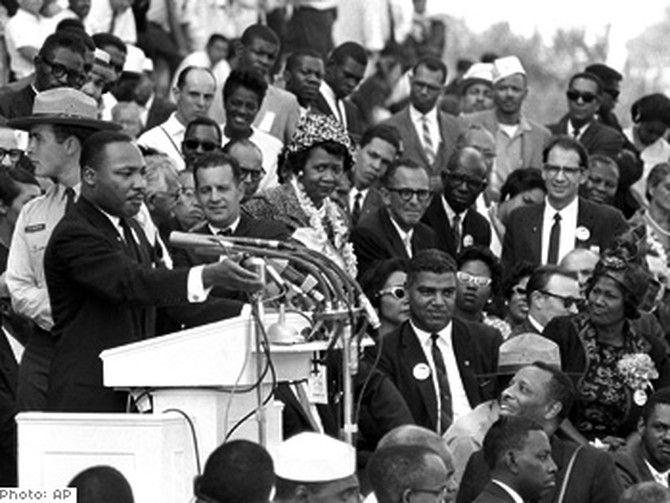
Every year, America pauses to remember Dr. Martin Luther King Jr., one of the most influential leaders in our nation's history. A Baptist minister by trade, Dr. King used the power of words to inspire a generation and change the course of history.
In 1963, Dr. King stood on the steps of Washington, D.C.'s Lincoln Memorial and delivered a powerful message to a crowd of more than 200,000 people. His speech, which is now taught in classrooms across the country, is best known for its powerful declaration, "I Have a Dream."
Dr. King's words raised the nation's awareness of the civil rights movement and helped him become the youngest person ever awarded the Nobel Peace Prize. Before his life was cut short by an assassin in 1968, the United States government passed the Civil Rights Act of 1964, as well as the Voting Rights Act of 1965.
Now, 45 years after Dr. King shared his dream with the world, Oprah returns to the spot where he stood on that fateful day in 1963 to celebrate his legacy. "We honor his message of hope," she says.
In 1963, Dr. King stood on the steps of Washington, D.C.'s Lincoln Memorial and delivered a powerful message to a crowd of more than 200,000 people. His speech, which is now taught in classrooms across the country, is best known for its powerful declaration, "I Have a Dream."
Dr. King's words raised the nation's awareness of the civil rights movement and helped him become the youngest person ever awarded the Nobel Peace Prize. Before his life was cut short by an assassin in 1968, the United States government passed the Civil Rights Act of 1964, as well as the Voting Rights Act of 1965.
Now, 45 years after Dr. King shared his dream with the world, Oprah returns to the spot where he stood on that fateful day in 1963 to celebrate his legacy. "We honor his message of hope," she says.

As Dr. King's message of freedom and equality spread throughout the country, citizens in a small Alabama town wondered if his vision would ever reach them.
For nearly 200 years, the Alabama River has separated the black citizens of Gee's Bend—a small peninsula surrounded by water on three sides—from their white neighbors in Camden. With no grocery stores, hospitals or job opportunities in Gee's Bend, residents travel by ferry to Camden for almost all their basic necessities.
In the 1960s, water was just one of many things that divided these two communities. Gee's Bend citizens joined the civil rights movement and began protesting segregation in Camden.
When they crossed the river, they were met with intimidation and intolerance. "When you leave home that morning to go march, you didn't know if you were going to make it back home or not," says Nettie, a 90-year-old Gee's Bend resident.
Hollis Curl, a former Camden judge, says no matter how hard the racists tried, they couldn't stop the growing tide of change. "Marching and demonstrating in the street and holding voting rallies…some of the movers and shakers in the county at that time wanted that stopped," he says. After one such demonstration, Judge Curl says he put 410 protestors behind bars.
Nettie says she was imprisoned for almost a week. "I went because we were marching, and they told us don't," she says. "But we did it anyway because we wanted our rights."
When Camden leaders realized they couldn't stop the protests, they stopped the ferry instead.
For nearly 200 years, the Alabama River has separated the black citizens of Gee's Bend—a small peninsula surrounded by water on three sides—from their white neighbors in Camden. With no grocery stores, hospitals or job opportunities in Gee's Bend, residents travel by ferry to Camden for almost all their basic necessities.
In the 1960s, water was just one of many things that divided these two communities. Gee's Bend citizens joined the civil rights movement and began protesting segregation in Camden.
When they crossed the river, they were met with intimidation and intolerance. "When you leave home that morning to go march, you didn't know if you were going to make it back home or not," says Nettie, a 90-year-old Gee's Bend resident.
Hollis Curl, a former Camden judge, says no matter how hard the racists tried, they couldn't stop the growing tide of change. "Marching and demonstrating in the street and holding voting rallies…some of the movers and shakers in the county at that time wanted that stopped," he says. After one such demonstration, Judge Curl says he put 410 protestors behind bars.
Nettie says she was imprisoned for almost a week. "I went because we were marching, and they told us don't," she says. "But we did it anyway because we wanted our rights."
When Camden leaders realized they couldn't stop the protests, they stopped the ferry instead.
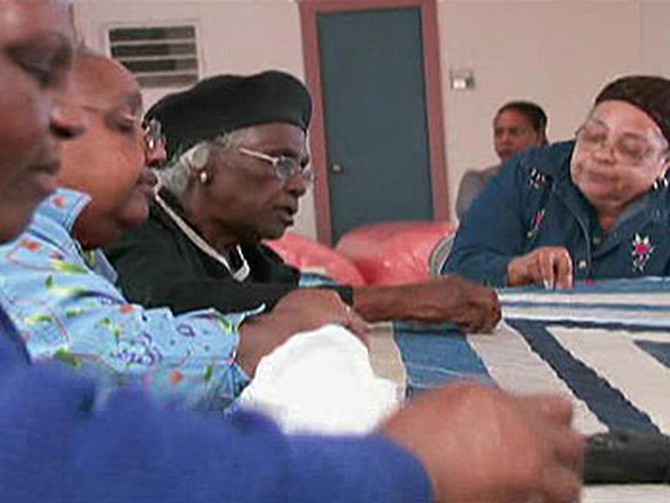
In the middle of the night, with no public meeting or notice, Gee's Bend's lifeline was shut down.
"One morning, my husband went down, and he came back and said, 'The ferry's gone,'" says Lucy, a longtime resident of Gee's Bend.
The cast-aside community became a virtually isolated island. Immersed in poverty, proud women who once labored as sharecroppers sat down at quilting bees and stitched their prayers into intricate tapestries.
Find out more about the Gee's Bend quilters.
To get groceries, medicine and an education, Gee's Benders were forced to travel nearly an hour by car, which few people owned. Emergency services were also far from reach. "My cousin's husband, he got sick," says Mary, a Gee's Bend resident. "He had a heart attack. … He died before he got to the hospital because the ambulance didn't come on time."
Despite heartache and hardships, the residents continued to pursue freedom and equality. Then, one day in 1965, Dr. King came to Gee's Bend to share his message of hope. "You may not have the other opportunities other people have, but you know that you are somebody," he said. "You are as good as any white person in Wilcox County. You've got to believe that!"
For many, Dr. King restored their faith in the future. "He said if we lived long enough, we would see little white boys, black boys and girls walk together," Lucy says.
"One morning, my husband went down, and he came back and said, 'The ferry's gone,'" says Lucy, a longtime resident of Gee's Bend.
The cast-aside community became a virtually isolated island. Immersed in poverty, proud women who once labored as sharecroppers sat down at quilting bees and stitched their prayers into intricate tapestries.
Find out more about the Gee's Bend quilters.
To get groceries, medicine and an education, Gee's Benders were forced to travel nearly an hour by car, which few people owned. Emergency services were also far from reach. "My cousin's husband, he got sick," says Mary, a Gee's Bend resident. "He had a heart attack. … He died before he got to the hospital because the ambulance didn't come on time."
Despite heartache and hardships, the residents continued to pursue freedom and equality. Then, one day in 1965, Dr. King came to Gee's Bend to share his message of hope. "You may not have the other opportunities other people have, but you know that you are somebody," he said. "You are as good as any white person in Wilcox County. You've got to believe that!"
For many, Dr. King restored their faith in the future. "He said if we lived long enough, we would see little white boys, black boys and girls walk together," Lucy says.
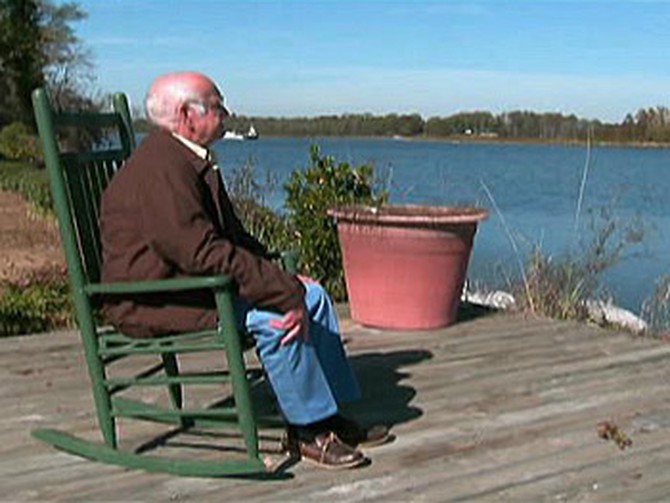
In 1990, Hollis Curl, the retired Camden judge who jailed civil rights protestors and supported segregation, began to have a change of heart about Gee's Bend.
"Over across the river, I could see the sky lit up. Something was burning," he says. "I learned later in the day that a house had burned down. They had no fire truck, no way to get a fire engine over there, no way to get back and forth across the river at all."
After that day, Hollis began writing editorials and letters in his newspaper, The Wilcox Progressive Era. He used this platform to voice his support of bringing back the Gee's Bend ferry. He wrote, "The hull was taken out of service in the '60s as a means of lessening racial tensions in Camden. That's a historical fact. With all of that behind us, it's time for officials black and white to step down and try to do something to benefit everybody for a change."
Camden's community leaders listened and united. In the summer of 2006, after 44 years of isolation, the Gee's Bend ferry took to the water once again.
"Over across the river, I could see the sky lit up. Something was burning," he says. "I learned later in the day that a house had burned down. They had no fire truck, no way to get a fire engine over there, no way to get back and forth across the river at all."
After that day, Hollis began writing editorials and letters in his newspaper, The Wilcox Progressive Era. He used this platform to voice his support of bringing back the Gee's Bend ferry. He wrote, "The hull was taken out of service in the '60s as a means of lessening racial tensions in Camden. That's a historical fact. With all of that behind us, it's time for officials black and white to step down and try to do something to benefit everybody for a change."
Camden's community leaders listened and united. In the summer of 2006, after 44 years of isolation, the Gee's Bend ferry took to the water once again.
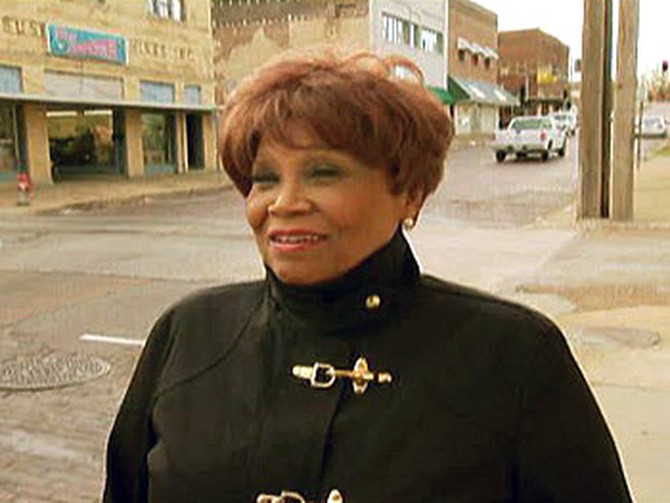
Oprah says Dr. King challenged people to see how we are all more alike than we are different…a lesson one New York woman learned when she embarked on a journey far from home.
In Harlem, New York, Vy Higginsen turned her passion for African-American culture and theater into the Mama Foundation for the Arts, a company that helps preserve gospel, blues and jazz music.
In her personal life, Vy also set out to preserve the memory of her ancestors. Since the death of her grandmother, Anna West, in 1978, Vy says she's been studying her family's history and searching for answers.
To determine her true ancestry, Vy took a DNA test…and received surprising results. The test revealed that she was 28 percent European. "I called the laboratory," she says. "[I said], 'It's got to be a mistake, something's wrong here. Where does this European blood come from? Who are these people?'"
Then, one day an unexpected caller gave Vy her answer.
In Harlem, New York, Vy Higginsen turned her passion for African-American culture and theater into the Mama Foundation for the Arts, a company that helps preserve gospel, blues and jazz music.
In her personal life, Vy also set out to preserve the memory of her ancestors. Since the death of her grandmother, Anna West, in 1978, Vy says she's been studying her family's history and searching for answers.
To determine her true ancestry, Vy took a DNA test…and received surprising results. The test revealed that she was 28 percent European. "I called the laboratory," she says. "[I said], 'It's got to be a mistake, something's wrong here. Where does this European blood come from? Who are these people?'"
Then, one day an unexpected caller gave Vy her answer.
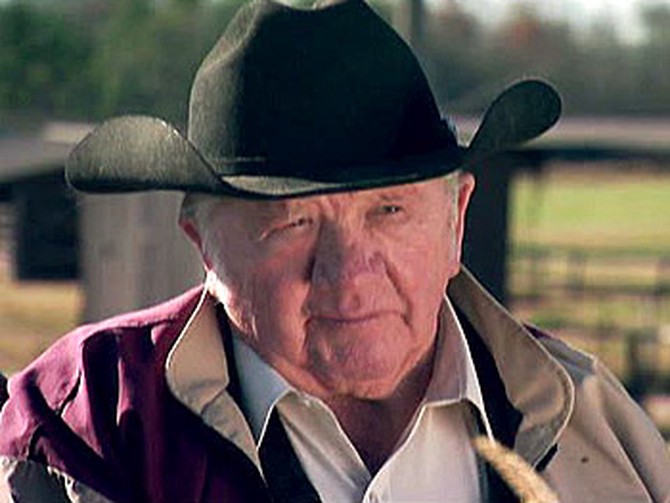
The man on the other end of the phone was Marion West, a retired cattle rancher from Poplar Bluff, Missouri. He was calling to introduce himself to Vy, his long-lost cousin.
"I didn't know she was African-American," Marion says. "I just called her up. I said, 'Hey kiddo, I hear you're my cousin,' and I talked to her a little bit. Then maybe a day or two later, I called and told her to come down for dinner."
Marion and Vy can thank modern science for helping them fill in their family tree. In 2005, Marion submitted a DNA test to a worldwide database, hoping to find people who share the last name West. The database revealed that Marion's grandfather and Vy's grandmother shared a last name and a link through blood.
After talking to Marion, Vy and her daughter Noelle decided to accept his dinner invitation and travel to Poplar Bluff.
"I didn't know she was African-American," Marion says. "I just called her up. I said, 'Hey kiddo, I hear you're my cousin,' and I talked to her a little bit. Then maybe a day or two later, I called and told her to come down for dinner."
Marion and Vy can thank modern science for helping them fill in their family tree. In 2005, Marion submitted a DNA test to a worldwide database, hoping to find people who share the last name West. The database revealed that Marion's grandfather and Vy's grandmother shared a last name and a link through blood.
After talking to Marion, Vy and her daughter Noelle decided to accept his dinner invitation and travel to Poplar Bluff.
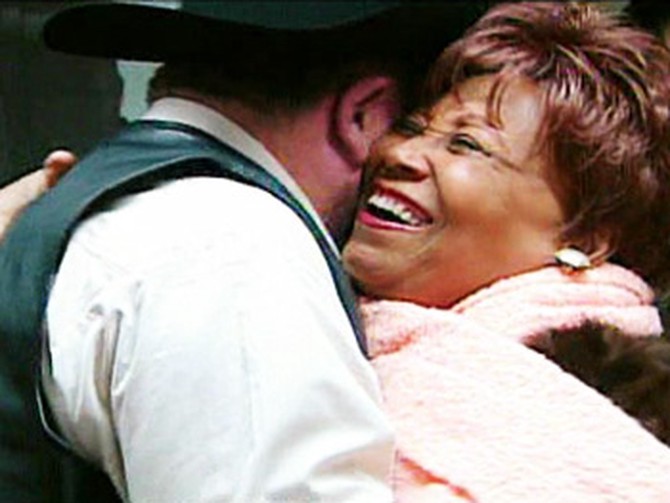
Vy and Marion's first meeting was a memorable one. "Now that was a moment," Vy says. "He looked like he was from central casting—he was an authentic cowboy! What he said when he threw his arms around us was, 'I prayed for this day. I'm so happy we are here together.'"
During her visit, Marion took his cousin on a tour of the 154-acre ranch where he was raised. Vy's ancestors likely worked in the fields owned by Marion's forefathers. "That's life," she says. "This is what it is. This is part of our history."
The cousins also visited Marion's special place, a grove of pine trees where he likes to reflect and pray. "This whole land and knowing there were ancestors on it…it's almost like magic," Vy says.
Though Vy and Marion don't look much like relatives, she says they feel like a family. "I think our story is one that brings people together and offers some hope and understanding about race in America," she says. "Once you get past the color, and all the other prejudices you have, you can discover that we really are the same."
During her visit, Marion took his cousin on a tour of the 154-acre ranch where he was raised. Vy's ancestors likely worked in the fields owned by Marion's forefathers. "That's life," she says. "This is what it is. This is part of our history."
The cousins also visited Marion's special place, a grove of pine trees where he likes to reflect and pray. "This whole land and knowing there were ancestors on it…it's almost like magic," Vy says.
Though Vy and Marion don't look much like relatives, she says they feel like a family. "I think our story is one that brings people together and offers some hope and understanding about race in America," she says. "Once you get past the color, and all the other prejudices you have, you can discover that we really are the same."
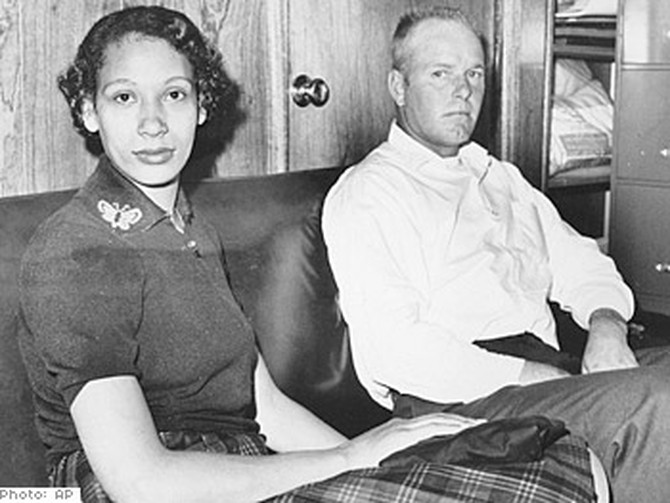
When Dr. King gave his historic speech in 1963, interracial marriage was not only socially unacceptable, it was illegal in 19 states. Men and women hid their true feelings out of fear until one courageous couple put their lives on the line for the right to build a life together.
In 1958, Mildred Jeter, a black woman, and Richard Loving, a white man, fell in love and wanted to get married. Since interracial marriage was against the law in their home state of Virginia, they traveled to Washington, D.C., to say "I do."
Shortly after returning home, the Lovings were dragged from their bedroom in the middle of the night, arrested and thrown in jail. As punishment, lawmakers decided to banish the couple from Virginia for 25 years.
Like Rosa Parks, Martin Luther King Jr. and other brave Americans who came before them, Mildred and Richard took a stand. They took their case all the way to the Supreme Court…and they won.
The 1967 case of Loving v. The State of Virginia legalized interracial marriage in America. Since then, it's estimated that more than 4 million interracial couples have married in the United States.
In 1958, Mildred Jeter, a black woman, and Richard Loving, a white man, fell in love and wanted to get married. Since interracial marriage was against the law in their home state of Virginia, they traveled to Washington, D.C., to say "I do."
Shortly after returning home, the Lovings were dragged from their bedroom in the middle of the night, arrested and thrown in jail. As punishment, lawmakers decided to banish the couple from Virginia for 25 years.
Like Rosa Parks, Martin Luther King Jr. and other brave Americans who came before them, Mildred and Richard took a stand. They took their case all the way to the Supreme Court…and they won.
The 1967 case of Loving v. The State of Virginia legalized interracial marriage in America. Since then, it's estimated that more than 4 million interracial couples have married in the United States.
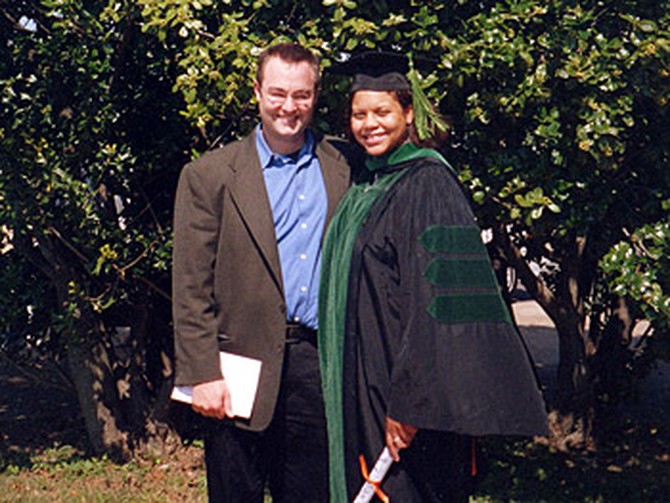
Deneta first met her husband, Bryan, when they were students at Harvard in 1989, but their friendship didn't blossom into romance until a decade later.
"I honestly thought, 'Oh, he's a nice guy,'" she says. "But he was a freshman and…"
"And white," Bryan says.
"Exactly," she says. "I said I wasn't going to date outside my race. So we were friends. I didn't want to get to a place like Harvard and feel like I'd forgotten where I had come from."
After graduation, Deneta and Bryan went their separate ways. He moved to Montgomery, Alabama, and became a civil rights lawyer. Deneta became a doctor in Memphis, Tennessee.
Ten years later, Deneta decided it was time to see Montgomery. She e-mailed her old friend out of the blue. "I'd never been to Montgomery," she says. "I wanted to come see all the civil rights tours and thought, 'I'm just going to go to Montgomery and visit my old friend.'"
"I honestly thought, 'Oh, he's a nice guy,'" she says. "But he was a freshman and…"
"And white," Bryan says.
"Exactly," she says. "I said I wasn't going to date outside my race. So we were friends. I didn't want to get to a place like Harvard and feel like I'd forgotten where I had come from."
After graduation, Deneta and Bryan went their separate ways. He moved to Montgomery, Alabama, and became a civil rights lawyer. Deneta became a doctor in Memphis, Tennessee.
Ten years later, Deneta decided it was time to see Montgomery. She e-mailed her old friend out of the blue. "I'd never been to Montgomery," she says. "I wanted to come see all the civil rights tours and thought, 'I'm just going to go to Montgomery and visit my old friend.'"
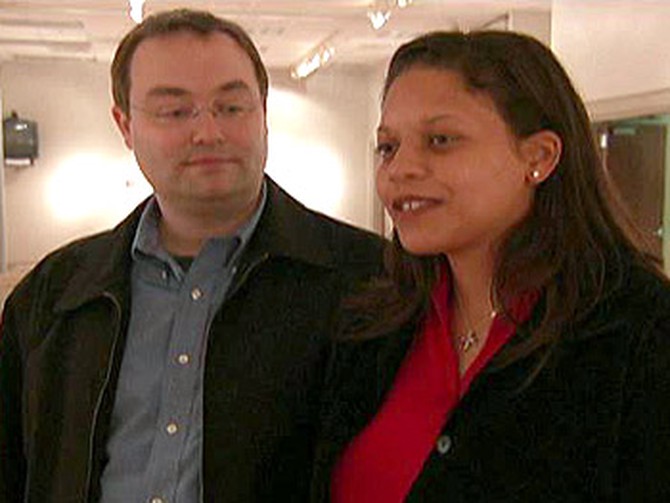
Little did Deneta know that she would fall in love with Bryan in a city so pivotal to the civil rights movement.
Bryan planned an entire weekend of sightseeing for the two of them, but it was something that could never be planned that really caught Deneta's attention. "I was surprised throughout our seeing all the different sites that I just saw how much they touched him personally. I guess I didn't really realize that it would. [I thought] these people look like my grandmother and my aunts and uncles and me, and so it must affect me more," she says. "But, you know, he loves his country too. It just helped me see him in a different way, I guess. I saw a little piece of his heart."
Bryan says Martin Luther King's vision continues in Montgomery even today. "One of the neat things about Montgomery is the that Dr. King's words really echo wherever you go, and coming to the church where he delivered many of those words, it's pretty special," he says. "It just boggles my mind to think how different our lives would be today, what would we be like as a nation if [the] civil rights movement hadn't in many ways redeemed us."
It took this fateful visit for some of Dr. King's most famous words to ring true for Deneta. "I think about Dr. King's speeches and all the words that he said about being judged not by the color of our skin, but by the content of our character, and I was attracted to Bryan's character and attracted to who he was as a person and realized I had been judging him by the color of his skin for 10 years and decided to that I needed to let that go."
And she did—Bryan and Deneta married on October 7, 2007.
Bryan planned an entire weekend of sightseeing for the two of them, but it was something that could never be planned that really caught Deneta's attention. "I was surprised throughout our seeing all the different sites that I just saw how much they touched him personally. I guess I didn't really realize that it would. [I thought] these people look like my grandmother and my aunts and uncles and me, and so it must affect me more," she says. "But, you know, he loves his country too. It just helped me see him in a different way, I guess. I saw a little piece of his heart."
Bryan says Martin Luther King's vision continues in Montgomery even today. "One of the neat things about Montgomery is the that Dr. King's words really echo wherever you go, and coming to the church where he delivered many of those words, it's pretty special," he says. "It just boggles my mind to think how different our lives would be today, what would we be like as a nation if [the] civil rights movement hadn't in many ways redeemed us."
It took this fateful visit for some of Dr. King's most famous words to ring true for Deneta. "I think about Dr. King's speeches and all the words that he said about being judged not by the color of our skin, but by the content of our character, and I was attracted to Bryan's character and attracted to who he was as a person and realized I had been judging him by the color of his skin for 10 years and decided to that I needed to let that go."
And she did—Bryan and Deneta married on October 7, 2007.

In his famous speech, Dr. King proclaimed: "I have a dream that one day, even the state of Mississippi, a state sweltering with the heat of injustice, sweltering with the heat of oppression, will be transformed into an oasis of freedom and justice."
When he said those powerful words, Mississippi wasn't the only state sweltering with the heat of hatred and violence. In 1964, Jacksonville, Florida, was in the throes of deadly race riots. In the midst of the turmoil, police say four young white men set out looking for trouble—they armed themselves and decided to kill a black person.
Across town, Johnnie Mae Chappell, a 35-year-old housekeeper and mother of 10, was walking home from work. "They just slowed down and shot Mrs. Chappell to death with a single shot from a .22-caliber revolver," says C. Lee Cody Jr., a former detective sergeant. "It was probably a good 10 miles to the nearest facility that would accept her. She couldn't go to a white hospital. And she bled to death. That was her cause of death."
Johnnie Mae Chappell's children honor her memory.
The only photo that still exists of Johnnie Mae Chappell was shot at the morgue. Her grieving husband, Willie, stands over her just hours after she died. "I remember that night," says Johnnie Mae's son, Willie Jr. "Our lives stopped. Our world shut down. It was like everything just froze in time."
When he said those powerful words, Mississippi wasn't the only state sweltering with the heat of hatred and violence. In 1964, Jacksonville, Florida, was in the throes of deadly race riots. In the midst of the turmoil, police say four young white men set out looking for trouble—they armed themselves and decided to kill a black person.
Across town, Johnnie Mae Chappell, a 35-year-old housekeeper and mother of 10, was walking home from work. "They just slowed down and shot Mrs. Chappell to death with a single shot from a .22-caliber revolver," says C. Lee Cody Jr., a former detective sergeant. "It was probably a good 10 miles to the nearest facility that would accept her. She couldn't go to a white hospital. And she bled to death. That was her cause of death."
Johnnie Mae Chappell's children honor her memory.
The only photo that still exists of Johnnie Mae Chappell was shot at the morgue. Her grieving husband, Willie, stands over her just hours after she died. "I remember that night," says Johnnie Mae's son, Willie Jr. "Our lives stopped. Our world shut down. It was like everything just froze in time."
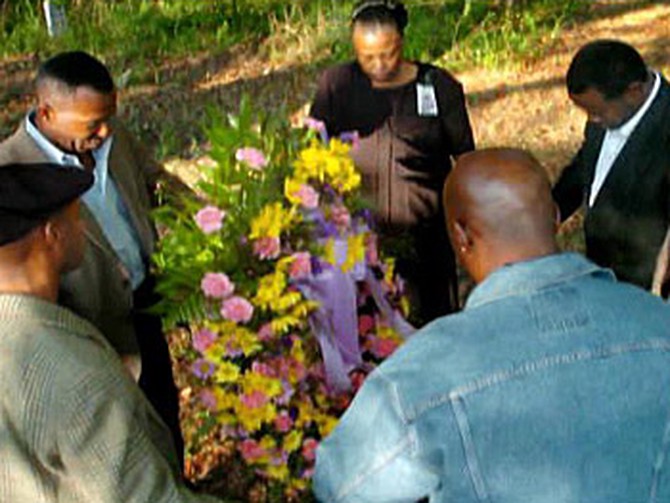
After Johnnie Mae's death, her husband, Willie, worked night and day to support his family. With little time spent at home, the state ruled Willie an unfit father and took his children away. "I can remember when we were taken away from my father," says Shelton, one of Willie and Johnnie Mae's sons. "I hadn't seen my brothers and sisters for years after that. We were put in separate foster homes."
Shelton, the youngest of 10, was just an infant when his mother died and has no memories of her. He grew up longing for his family and always wondered what really happened on that dark night in 1964. "I knew there was more information out there than what I had known or heard. If you read back in some of the newspapers back then, they barely put anything in there about our mother being killed," Shelton says.
Shelton, the youngest of 10, was just an infant when his mother died and has no memories of her. He grew up longing for his family and always wondered what really happened on that dark night in 1964. "I knew there was more information out there than what I had known or heard. If you read back in some of the newspapers back then, they barely put anything in there about our mother being killed," Shelton says.

C. Lee Cody Jr. was a detective sergeant with the sheriff's office when Johnnie Mae Chappell was killed. Lee says the sheriff's department did not assign anyone to investigate the murder, so he and his partner took on the case themselves.
Lee says he and his partner arrested the suspects, got full confessions and found the murder weapon. Still, Lee says charges against three of the four men were completely dropped. "Here is a black woman gunned down in cold blood on a dark, lonely highway, and none of them cared. We lived in a racist city and a racist town run by racist people," Lee says.
Outraged, Lee demanded answers from his bosses. Soon after, he was fired and his life began to unravel. "I got a job driving a garbage truck, and I wasn't a very good husband, and I drank too much," he says. "I was eaten up with it, there's no doubt about it."
Lee says he and his partner arrested the suspects, got full confessions and found the murder weapon. Still, Lee says charges against three of the four men were completely dropped. "Here is a black woman gunned down in cold blood on a dark, lonely highway, and none of them cared. We lived in a racist city and a racist town run by racist people," Lee says.
Outraged, Lee demanded answers from his bosses. Soon after, he was fired and his life began to unravel. "I got a job driving a garbage truck, and I wasn't a very good husband, and I drank too much," he says. "I was eaten up with it, there's no doubt about it."
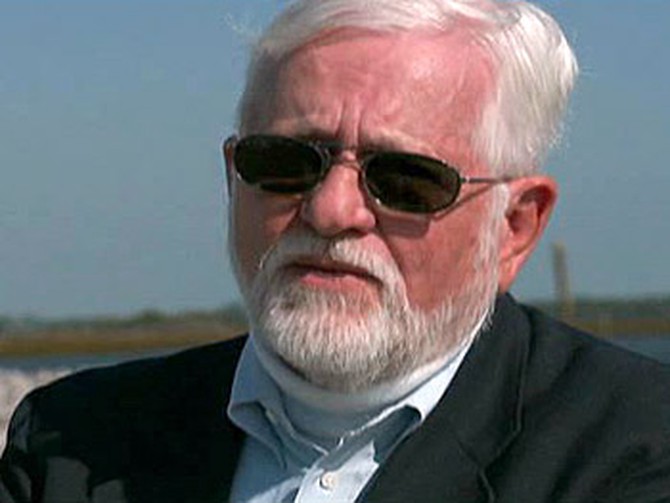
Decades later, in 1996, Lee saw something in the newspaper that would change everything. "I happened to see a picture of a black man kneeling down [at a gravesite]," Lee says. "It just caught my eye, and I stopped and just kind of looked at it, and I saw the name Chappell. Then, of course, that piqued my interest."
Lee read that Johnnie Mae's grown children were planning a proper memorial for their mother 32 years after her murder. Lee knew he had to be there. "I said, 'Well, if you don't go, and you don't tell the family members if they're there—Shelton, whomever—how their mother was criminally violated, they'll never know,'" he says.
Lee attended the service and told Shelton everything he knew about that night—and the blatant injustice that followed. "He looked at me and a little tear rolled down his cheek," Lee says. "And he said, 'Will you help us?' And I said, 'Yep.'"
Lee read that Johnnie Mae's grown children were planning a proper memorial for their mother 32 years after her murder. Lee knew he had to be there. "I said, 'Well, if you don't go, and you don't tell the family members if they're there—Shelton, whomever—how their mother was criminally violated, they'll never know,'" he says.
Lee attended the service and told Shelton everything he knew about that night—and the blatant injustice that followed. "He looked at me and a little tear rolled down his cheek," Lee says. "And he said, 'Will you help us?' And I said, 'Yep.'"
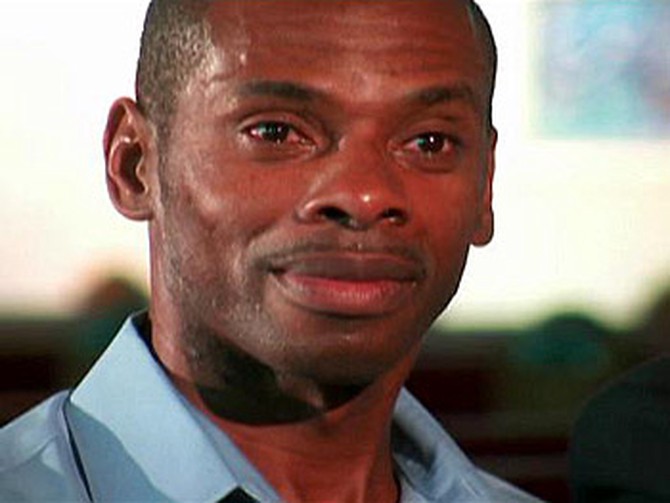
Shelton and Lee—two men from completely different worlds— had spent decades tormented by the same senseless crime. Now, things were about to change as they embarked on a journey for justice together.
The stretch of highway where Johnnie Mae was gunned down is now named for her. Johnnie Mae's name also hangs on the wall of the Southern Poverty Law Center, a place of great honor.
But the bond between Shelton and Lee transcends their pursuit of justice. Today, the little boy who grew up longing for a family has found comfort in an unexpected place. "[Lee's] like a father figure, just a great friend," Shelton says.
"I love Shelton like my own children," Lee says.
Together, they continue their fight. Shelton and Lee have taken their story all the way to the justice department. They say they won't stop until Johnnie Mae's case is reopened and federal charges are brought against the men alleged to be involved in the murder.
"Dr. King had a dream," Shelton says. "He has laid out the road map to justice. And I listen to his speeches all the time to remind me."
"I thank God for him because I'm able to not be bitter and not have that hatred. … My mother would say fight on until justice is done."
The stretch of highway where Johnnie Mae was gunned down is now named for her. Johnnie Mae's name also hangs on the wall of the Southern Poverty Law Center, a place of great honor.
But the bond between Shelton and Lee transcends their pursuit of justice. Today, the little boy who grew up longing for a family has found comfort in an unexpected place. "[Lee's] like a father figure, just a great friend," Shelton says.
"I love Shelton like my own children," Lee says.
Together, they continue their fight. Shelton and Lee have taken their story all the way to the justice department. They say they won't stop until Johnnie Mae's case is reopened and federal charges are brought against the men alleged to be involved in the murder.
"Dr. King had a dream," Shelton says. "He has laid out the road map to justice. And I listen to his speeches all the time to remind me."
"I thank God for him because I'm able to not be bitter and not have that hatred. … My mother would say fight on until justice is done."
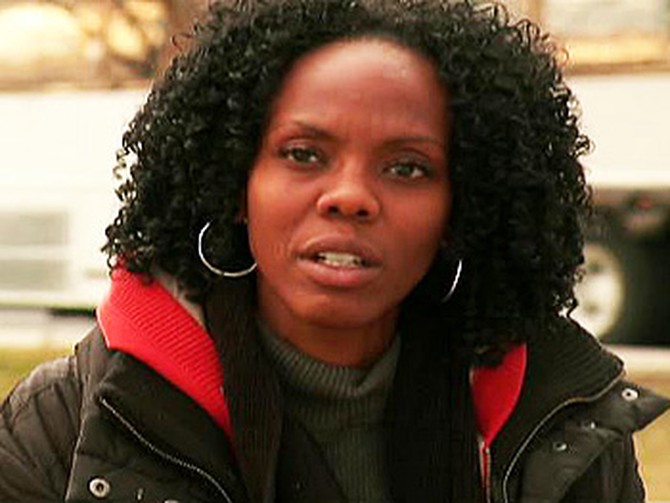
Forty-five years after the "I Have a Dream" speech, ordinary citizens across the country are giving it all they've got to keep Dr. King's vision for a better future alive—including a Los Angeles bus driver named Tanya.
"About eight years ago, I was driving a rough route," she says. "Most of the kids on my bus were known for getting suspended, kicked out of school."
Recognizing their daily struggle, Tanya decided to try a special approach. "I learned to speak to my students everyday," she says. "I learned to smile at them, I learned to give them a hug if they needed a hug. I learned to give them encouragement, and from that I built trust."
With each day, Tanya became more and more invested in the future of her students. "I asked each one of them to show me their report card. And I was shocked to find out the majority of my students were failing," she says. "I said, 'How is it that I'm bringing you to school everyday and still you're failing? I don't understand.' I decided to challenge each student to bring up their grades."
"About eight years ago, I was driving a rough route," she says. "Most of the kids on my bus were known for getting suspended, kicked out of school."
Recognizing their daily struggle, Tanya decided to try a special approach. "I learned to speak to my students everyday," she says. "I learned to smile at them, I learned to give them a hug if they needed a hug. I learned to give them encouragement, and from that I built trust."
With each day, Tanya became more and more invested in the future of her students. "I asked each one of them to show me their report card. And I was shocked to find out the majority of my students were failing," she says. "I said, 'How is it that I'm bringing you to school everyday and still you're failing? I don't understand.' I decided to challenge each student to bring up their grades."
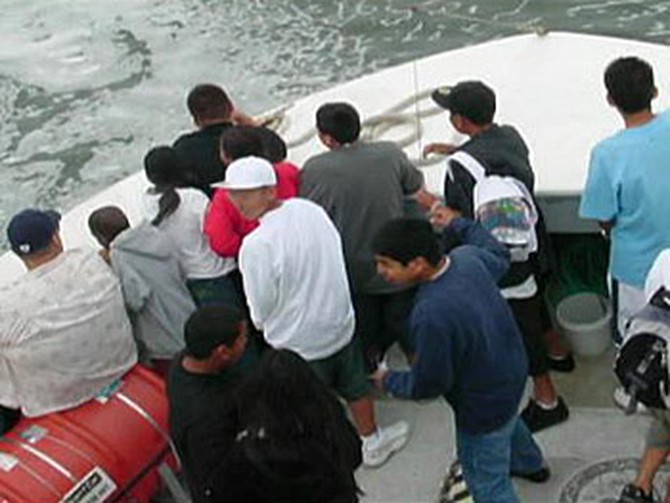
Five weeks after Tanya's challenge, 54 of her students hit the books and improved their grades. As a reward, Tanya took them to a place they'd never been before—a marine biology cruise just a short ride away from the inner city.
"That was where a few of my students pulled me to the side and said, 'Miss Walters, I didn't realize there was a life outside my community,'" she says. "And that gave me the strength to know that I had a purpose in life."
Tanya says she decided to max out her credit cards, buy a bus and set out on a journey to expose teens to a world beyond their crime-ridden neighborhoods. "By having the opportunity to travel, now they're having the opportunity to dream, and they're able to see that there is a place out there for [them] somewhere. Not just [their] community," Tanya says.
In 2006, Tanya enlisted the help of fellow bus drivers and volunteers to start Godparents Youth Organization so she could offer her classroom on wheels to children all over America. In just a few years, Tanya has taken students to America's most important civil rights landmarks and museums across 26 states.
Tanya says understanding where they come from helps the kids envision brighter futures. "They're able to link history together, and I think that's what our youth need right now is to know that people came from all walks of background and [have] struggled for all different reasons."
"That was where a few of my students pulled me to the side and said, 'Miss Walters, I didn't realize there was a life outside my community,'" she says. "And that gave me the strength to know that I had a purpose in life."
Tanya says she decided to max out her credit cards, buy a bus and set out on a journey to expose teens to a world beyond their crime-ridden neighborhoods. "By having the opportunity to travel, now they're having the opportunity to dream, and they're able to see that there is a place out there for [them] somewhere. Not just [their] community," Tanya says.
In 2006, Tanya enlisted the help of fellow bus drivers and volunteers to start Godparents Youth Organization so she could offer her classroom on wheels to children all over America. In just a few years, Tanya has taken students to America's most important civil rights landmarks and museums across 26 states.
Tanya says understanding where they come from helps the kids envision brighter futures. "They're able to link history together, and I think that's what our youth need right now is to know that people came from all walks of background and [have] struggled for all different reasons."
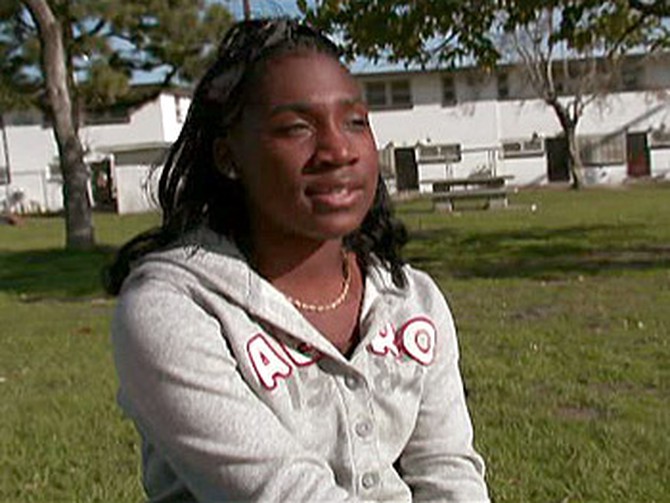
Sixteen-year-old Shamika had little hope for the future when she took her first road trip with Tanya, but she says she gained a whole new perspective. "This really opened my eyes and explained to me what my morals should be. It put my priorities back in order," she says. "Most of my friends over here are gangbangers. They're caught up into this lifestyle. Martin Luther King, he never showed any type of violence, and if he can do it—if he can do it—I can do it."
On her most recent bus trip, Shamika acted as a mentor for younger children. "They do count on me to step up and be a leader and let the other kids that are new know right from wrong," Shamika says.
Tanya believes her greatest victory has been helping young people like Shamika. "They go through life, and they think that they can't achieve. They think that they won't amount to anything. And it's not such!" Tanya says. "My goal, when I bring our kids together, is for them to dream again, for them to bring back hope. Because when you have hope, you have determination."
On her most recent bus trip, Shamika acted as a mentor for younger children. "They do count on me to step up and be a leader and let the other kids that are new know right from wrong," Shamika says.
Tanya believes her greatest victory has been helping young people like Shamika. "They go through life, and they think that they can't achieve. They think that they won't amount to anything. And it's not such!" Tanya says. "My goal, when I bring our kids together, is for them to dream again, for them to bring back hope. Because when you have hope, you have determination."

In 1963, Martin Luther King Jr. put his dream for freedom, equality and
brotherhood into words and ignited the hearts and minds of millions. "I have a
dream that my four little children will one day live in a nation where they will
not be judged by the color of their skin but by the content of their character,"
he said.
"There's words to a song I love that goes: 'You've got to be taught to hate and fear. You've got to be taught from year to year. It's got to be drummed in your dear little ear. You've got to be carefully taught,'" Oprah says.
"This generation, however, is the most colorblind in history. And they have the unique opportunity to lead us further into the dream and beyond," she says. "Now, as we pay homage to what would have been his 79th birthday, I ask this question—How will his dream live in you?"
"There's words to a song I love that goes: 'You've got to be taught to hate and fear. You've got to be taught from year to year. It's got to be drummed in your dear little ear. You've got to be carefully taught,'" Oprah says.
"This generation, however, is the most colorblind in history. And they have the unique opportunity to lead us further into the dream and beyond," she says. "Now, as we pay homage to what would have been his 79th birthday, I ask this question—How will his dream live in you?"
Published 03/14/2008

